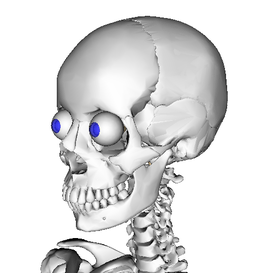THE NECK’S NORMAL RANGES OF MOTION, AND
CONSEQUENCES OF RESTRICTED MOVEMENT
NORMAL RANGES OF MOTION; CERVICAL SPINE
- FLEXION & EXTENSION: These involve being able to move your head both forward and backward respectively. They are the ranges of motion you would use to nod “yes”. They should be good enough to allow you to set a glass of water on your forehead when in Extension, and be able to put your chin on your chest in Flexion (or nearly on your chest if you are particularly thin).
- RIGHT AND LEFT ROTATION: These two are easy. Can you turn your head right and left such as you would do when you nod your head “no”? If so, you are engaging in Cervical Rotation. You should be able to get your nose over mid-shoulder (or at the very least, the front of your shoulder).
- RIGHT AND LEFT LATERAL FLEXION: These are the movements you would use when you put your ear towards your shoulder (do not cheat and shrug your shoulder up towards your ear). Looking in a mirror, these should be about 45 degrees.
The reason it is so important to know this information is because it is something that your medical doctor is highly unlikely to test when doing your ANNUAL PHYSICAL. And besides that, you can perform the test in the privacy of your own home anyway. When you do the test (in a mirror, have someone watch you, video yourself), simply look for gross deficiencies, differences between the right and left, or discomfort / pain at the end-range. Simple!
Oh; and don’t forget to test the speed of muscle contraction as well (see the quote in red at the top of the page). If you (or your subject) are able, do these ROM’s very slowly the first time around. Then test the ability to go through each of the six ranges rapidly. In other words, is it a problem when to move your nose over your right shoulder rapidly, as compared to slowly and deliberately?
Just be sure to understand that it is quite possible to have a “normal” ROM of your neck and still be restricted (HERE). There are several reasons this can happen. For one, everyone is different. Some people are quite flexible, while others were born stiff and inflexible. This is why comparing right to left is so important. For another, you might have VERTEBRAL SUBLUXATION. If areas of the spine are misaligned or not moving freely in relationship to each other, tissues on one side of the spine (or even above or below the locked segment[s]) might be making up the difference. Another reason for this might be that there is ADHESED FASCIA present. In other words, ROM is a wonderful (simple) test, but does not necessarily tell the whole story.
The bottom line is that LOSS OF ALIGNMENT and LOSS OF MOVEMENT have the ability to cause a multitude of problems — including problems with your organs (HERE). Deal with these restrictions up front, and you will live a longer, more fruitful, more productive, and less painful life.

